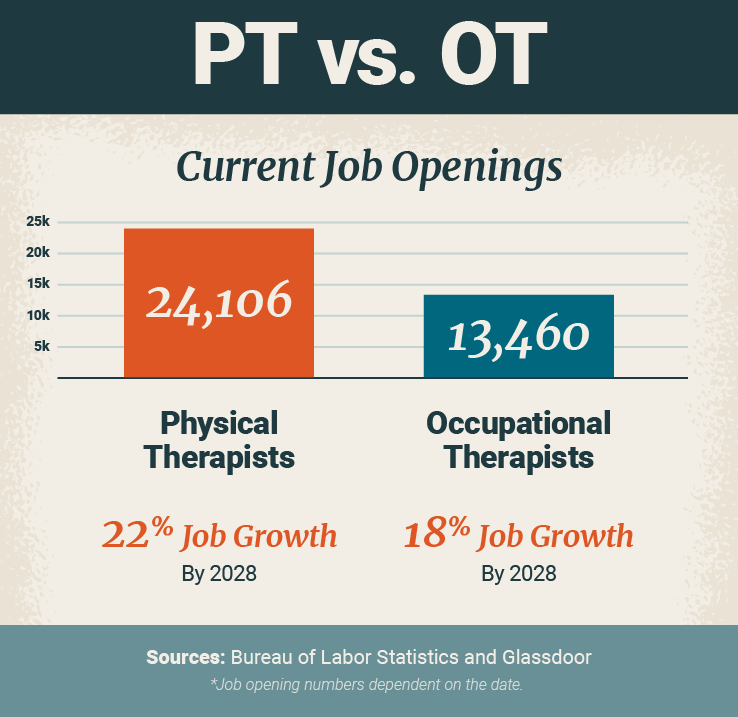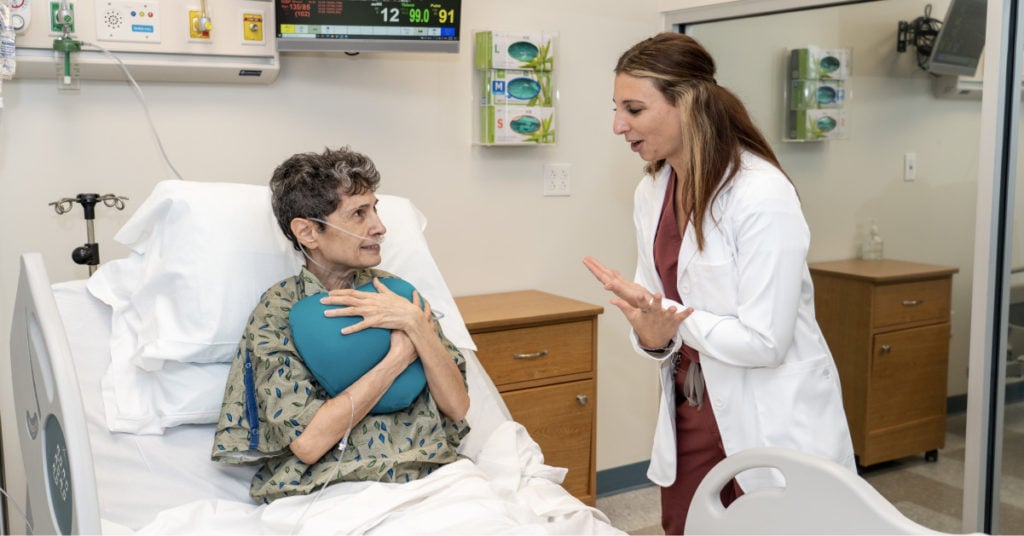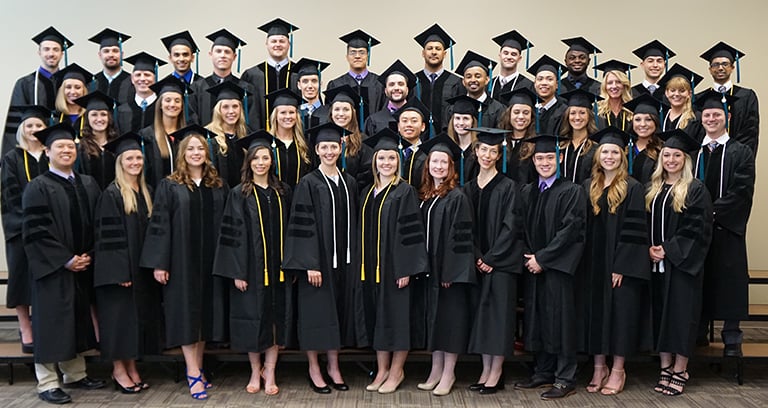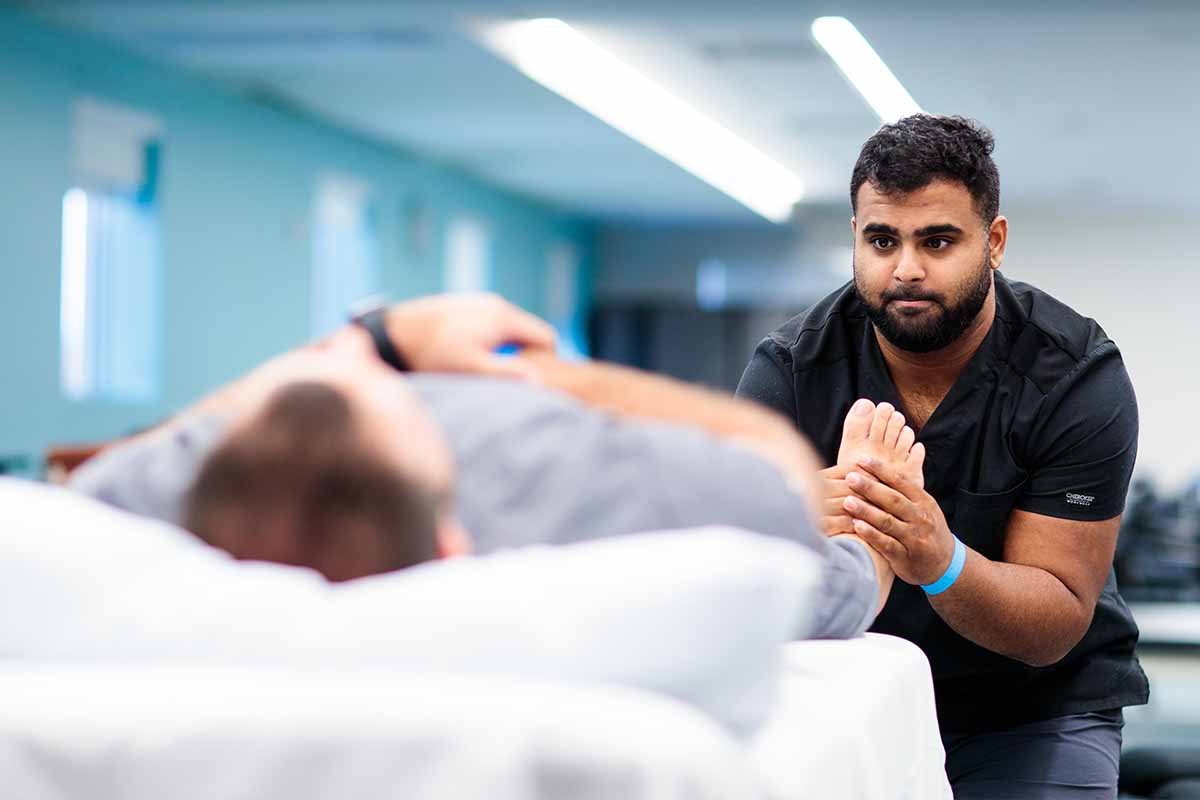

Physical therapy and occupational therapy are both rehabilitative disciplines that require hands-on work—leading many people to believe they are interchangeable. However, these professions vary greatly. When deciding which healthcare career is right for you, it’s important to know the differences between occupational therapy vs physical therapy that set these two roles apart.
How is Occupational Therapy different from Physical Therapy?
The Main Difference
There is one main difference between occupational and physical therapy: Occupational therapy is used to help or regain patients’ ability to perform everyday activities on their own, while physical therapy is used to improve patients’ ability to move their bodies and manage their pain.
While both professions focus on clients who are recovering from injuries, occupational therapists also assist patients who have cognitive or developmental disabilities that affect their motor skills, behavior or emotions. For example, if you need help getting dressed or taking a shower, you would go to occupational therapy. If you need help recovering after giving birth or improving movement in a sprained ankle, you would go to physical therapy.
OT vs PT: Other Differences
But the differences between occupational therapy and physical therapy extend beyond job descriptions. Below, we outline the differences in education, specialties, job duties and job outlook.
Job functions
So, what does an OT do? The skill sets of physical and occupational therapists overlap in several areas. In fact, several physical therapy techniques are used in occupational therapy, and vice versa. Because physical therapists work primarily with people recovering from musculoskeletal injuries, they use exercises, massage, and other techniques to restore function, prevent disability, and reduce pain in patients.¹ Their responsibilities include:
- Consulting with patients to learn about their physical condition and symptoms
- Performing physical therapy evaluations according to APTA standards
- Developing a treatment plan for patients
- Teaching patients therapeutic exercise techniques
- Promoting healing through massage or electrical stimulation
- Assisting patients with the use of exercise equipment
- Maintaining patient records
- Keeping track of patient goals and progress to evaluate mobility and strength
- Offering in-home exercises and treatment options
While occupational therapists focus on helping patients recover from physical injuries, their main focus is on activities of daily living (ADLs), such as brushing teeth, doing laundry, etc. OTs develop plans to help patients accomplish these everyday activities in an easier or less painful way.² Their responsibilities include:
- Assessing the patient’s functional abilities, including sensory, cognitive, emotional, and physical elements
- Developing a treatment plan
- Helping the patient achieve goals set in the treatment plan
- Creating and using assistive technology to promote independence in daily activities
- Helping patients improve their fine motor skills needed for meaningful daily tasks, such as getting dressed or writing checks
- Working with patients who have memory loss or other cognitive issues
- Providing home exercises for patients and recommendations for continued therapy
Physical therapists and occupational therapists can work in a variety of settings, including acute care, inpatient and outpatient settings, long-term care, schools, home health environments, and skilled nursing facilities. While the job duties of these professions do differ, physical therapists and occupational therapists often collaborate on teams.
Education
Physical Therapy Education
In order to become a physical therapist, you need to:
- Earn a bachelor’s degree, preferably in a health-related field.
- Attend graduate school to earn your Doctor of Physical Therapy degree. DPT programs typically take about three years to complete; however, time to completion can vary, depending on the program and other factors.
- Pass the National Physical Therapy Examination (NPTE) administered by the Federation of State Boards of Physical Therapy to become a licensed physical therapist in your state.³
Occupational Therapy Education
To become an occupational therapist, you must:
- Earn your bachelor’s degree in a health-related field.
- Earn at least a Master of Occupational Therapy degree. MOT programs typically take around two years to complete, but again, time to completion can vary.
- Pass the National Board of Certification of Occupational Therapy (NBCOT) examination to practice in your state.
If you want to deepen your knowledge of the field and further your occupational therapy career opportunities, you can opt to earn your Doctor of Occupational Therapy instead of a master’s.4
Specialties & certifications
Once you are licensed, you can become certified in a specialty area. Many physical and occupational therapists specialize in one or more areas over the course of their careers. Typically it’s necessary to earn a certificate and meet other eligibility requirements.
The American Board of Physical Therapy Specialties (ABPTS) and the American Occupational Therapy Association (AOTA) offer board certification in several areas for physical therapists and occupational therapists. (Check with the AOTA about their certification process, as it is currently in flux.)
Below are popular physical therapy and occupational therapy examples for specializations and certifications.
| Physical Therapy Specialties | Occupational Therapy Specialties |
| Cardiovascular & Pulmonary Certified Specialist (CCS) | Physical Rehabilitation (BCPR) |
| Clinical Electrophysiologic Certified Specialist (ECS) | Driving and Community Mobility (SCDCM or SCDCM-A) |
| Geriatric Certified Specialist (GCS) | Gerontology (BCG) |
| Neurologic Certified Specialist (NCS) | Environmental Modification (SCEM or SCEM-A) |
| Orthopedic Certified Specialist (OCS) | Feeding, Eating, and Swallowing (SCFES or SCFES-A) |
| Pediatric Certified Specialist (PCS) | Pediatrics (BCP) |
| Sports Certified Specialist (SCS) | Low Vision (SCLV or SCLV-A) |
| Women’s Health Certified Specialist (WCS) | Mental Health (BCMH) |
Salary & job outlook


Both professions have a healthy median salary and are expected to enjoy strong job growth within the next 10 years. According to the U.S. Bureau of Labor Statistics, occupational therapy is projected to see 17% job growth from 2020 to 2030. Similarly, physical therapy has a projected job growth rate of 21% from 2020 to 2030. The median wage of an occupational therapist was $85,570 in 2021,5 while the median wage of a physical therapist was $95,620.6
Choosing the Right Career Path for You
The roles of both occupational therapists and physical therapists are fundamental to rehabilitative healthcare. However, there are several differences that define each. Occupational therapy requires an understanding of mental health and assists patients in their ability to complete everyday tasks. Physical therapy focuses on helping patients decrease pain and recover range of motion from anatomical injuries.
If you are looking to become an occupational or physical therapist, you must first acquire your bachelor’s degree and then complete a graduate degree program in your chosen field. When choosing a grad school, make sure you find one that has the proper resources needed to achieve your career goals.
At the University of St. Augustine for Health Sciences, we offer both entry-level and transitional programs in rehabilitative sciences for students interested in entering into or advancing their careers. Contact our admissions office today to start your journey to becoming an occupational therapist or physical therapist.
Sources:
Bureau of Labor Statistics (1) (2) | Glassdoor (1) (2)








